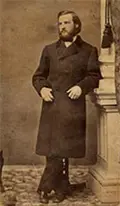Grover Cleveland: Reformer President
Part 1: Early Life and First Term Grover Cleveland was twice President of the United States, the only person to achieve that feat in non-consecutive terms. 
He was born Stephen Grover Cleveland on March 18, 1838, in Caldwell, N.J. His father, Richard Cleveland, was a Presbyterian minister. He and his wife, Anne, had nine children, of which Stephen was the fifth. Richard Cleveland died in 1853, when Stephen was 12, and the boy, having gone to the Fayette Academy and the Clinton Liberal Academy, left school and went to work. He taught at a school for the blind in New York City and then found work clerking at a Buffalo law firm. He passed the bar in 1859, worked for a well-known Buffalo law firm for a time, and started his own firm, in 1862. He also served as the Erie County assistant district attorney. Cleveland's first foray into politics was in 1865, when he ran for district attorney. He lost that election. He was first electoral success was as the sheriff of New York's Eric County; he was elected to that position in 1870. He served one term, then returned to his law practice. Returning to politics, he won election as Buffalo's mayor in 1882. He enjoyed a rapid rise in the ranks of the Democratic Party, mainly because of his stark opposition to the dominance of political machines, notably New York City's Tammany Hall. Cleveland (who had by this time dropped his first name and wished to be referred to as Grover) won election as the Governor of New York and began his term in 1883. A champion of political reform and of eliminating wasteful spending, he vetoed eight spending bills in his first two months in office. This further angered John Kelly and his machine, Tammany Hall. Cleveland, however, enjoyed the support of another famous reformer, the future President Teddy Roosevelt. Cleveland rose even further in political circles, gaining the Democratic Party's nomination for president in 1884. His opponent in the general election was Maine Senator James G. Blaine. Both candidates confronted political scandals during the campaign, and Cleveland won a narrow victory, thanks in part to support from the "Mugwumps," Republicans who voted not for Blaine but for Cleveland, because of his reformist policies. Not surprisingly, given his political preference, Cleveland continued the policy of basing political appointments on merit, not party affiliation. His predecessor in the White House, Chester A. Arthur, had made waves for doing so. Also wielding the power of the presidency, Cleveland vetoed a great many bills. One of the issues to which he paid special attention was bills to grant private pensions to Civil War veterans. He discovered that many of these claims were fraudulent and had already been denied by the Pension Bureau. In many cases, he studied the cases themselves in order to determine their legitimacy. (Cleveland had not fought in the Civil War himself, despite being of serviceable age and fitness; rather, he had paid someone to take a place–a common practice at the time.) In his first year in office, Cleveland faced a succession crisis. His Vice-president, Thomas Hendricks, died, in November 1885. This prompted Congress to pass another Presidential Succession Act, providing that members of the Cabinet could succeed to the Vice-presidency and the Presidency if needed. Cleveland did not nominate a successor to Hendricks, and the Vice-president's office remained vacant throughout Cleveland's term. 
In 1886, Cleveland, 48 married Frances Folsom, 21. She was a student at Wells College at the time and had been his ward; her father was Cleveland's former law partner. They were married in the White House. They had five children together. Cleveland was an opponent of protective tariffs, and this opposition was one of the issues that contributed to his defeat in 1888, in his bid for re-election. On election day, Cleveland and the Democrats garnered more popular votes than Harrison and the Republicans, but it was the Electoral College that determined the winner, as always, and Harrison, by less than 1 percent, managed to win Cleveland's home state, New York, and with it, the election. The final popular vote tally had Harrison ahead by just more than 90,000 votes, out of nearly 10.5 million votes cast. The final electoral tally was 233–168, to Harrison. As First Lady Frances Cleveland left the White House, she assured the staff that she and her husband would come back in four years' time. Next page > Second Term and Retirement > Page 1, 2 |
|
Social Studies for Kids
copyright 2002–2024
David White




